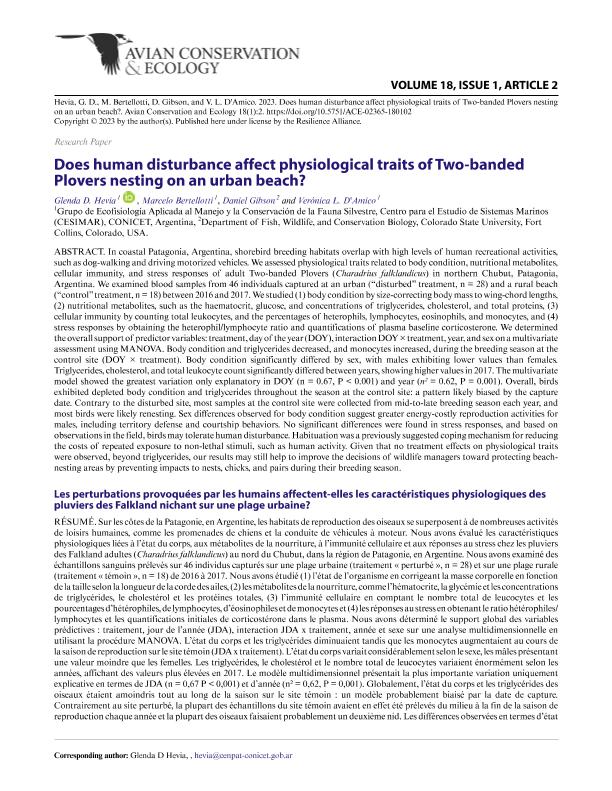Artículo
Does human disturbance affect physiological traits of Two-banded Plovers nesting on an urban beach?
Fecha de publicación:
01/2023
Editorial:
Resilience Alliance
Revista:
Avian Conservation and Ecology
ISSN:
1712-6568
Idioma:
Inglés
Tipo de recurso:
Artículo publicado
Clasificación temática:
Resumen
In coastal Patagonia, Argentina, shorebird breeding habitats overlap with high levels of human recreational activities, such as dog-walking and driving motorized vehicles. We assessed physiological traits related to body condition, nutritional metabolites, cellular immunity, and stress responses of adult Two-banded Plovers (Charadrius falklandicus) in northern Chubut, Patagonia, Argentina. We examined blood samples from 46 individuals captured at an urban (?disturbed? treatment, n=28) and a rural beach (?control? treatment, n=18) between 2016-2017. We studied 1) body condition by size-correcting body mass to wing-chord lengths, 2) nutritional metabolites, such as the hematocrit, glucose, and concentrations of triglycerides, cholesterol, and total proteins, 3) cellular immunity by counting total leukocytes, and the percentages of heterophils, lymphocytes, eosinophils, and monocytes, and 4) stress responses by obtaining the heterophil/lymphocyte. ratio and quantifications of plasma baseline corticosterone. We determined the overall support of predictor. variables: treatment, day of the year (DOY), interaction DOY×treatment, year, and sex on a multivariate assessment using MANOVA. Body condition and triglycerides decreased, and monocytes increased, during the breeding season at the control site (DOY×treatment). Body condition significantly differed by sex, with males exhibiting lower values than females. Triglycerides, cholesterol, and total leukocyte count significantly differed between years, showing higher values in 2017. The multivariate model showed the greatest variation only explanatory in DOY (n =0.67, P < 0.001) and year (n2=0.62, P=0.001). Overall, birds exhibited depleted body condition and triglycerides throughout the season at the control site: a pattern likely biased by the capture date. Contrary to the disturbed site, most samples at the control site were collected from mid-to-late breeding season each year, and most birds were likely renesting. Sex differences observed for body condition suggest greater energy-costly reproduction activities for males, including territory defense and courtship behaviors. No significant differences were found in stress responses, and based on observations in the field, birds may ?tolerate? human disturbance. Habituation was a previously suggested coping mechanism for reducing the costs of repeated exposure to non-lethal stimuli, such as human activity. Given that no treatment effects on physiological traits were observed, beyond triglycerides, our results may still help to improve the decisions of wildlife managers toward protecting beach-nesting areas by preventing impacts to nests, chicks, and pairs during their breeding season.
Archivos asociados
Licencia
Identificadores
Colecciones
Articulos(CESIMAR)
Articulos de CENTRO PARA EL ESTUDIO DE SISTEMAS MARINOS
Articulos de CENTRO PARA EL ESTUDIO DE SISTEMAS MARINOS
Citación
Hevia, Glenda Denise; Bertellotti, Néstor Marcelo; Gibson, Daniel; D'amico, Veronica Laura; Does human disturbance affect physiological traits of Two-banded Plovers nesting on an urban beach?; Resilience Alliance; Avian Conservation and Ecology; 18; 1; 1-2023; 1-15
Compartir
Altmétricas




